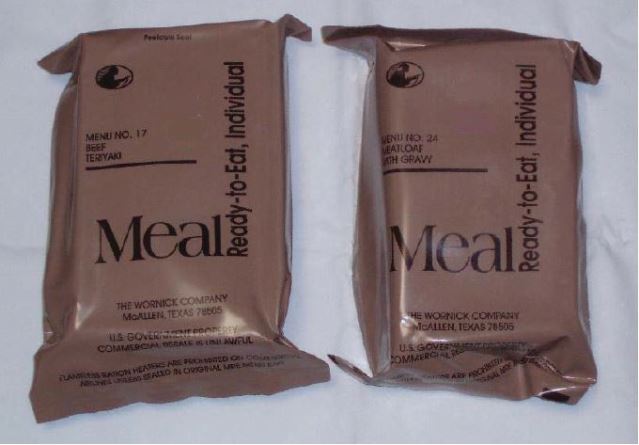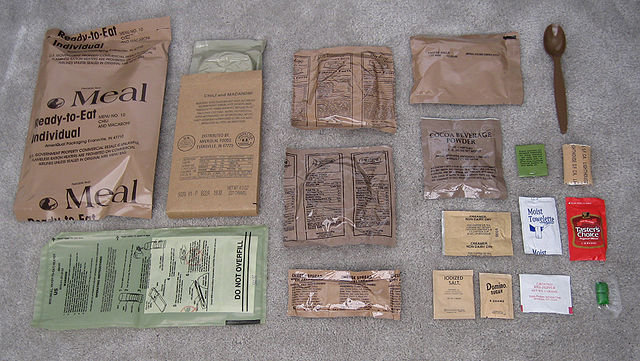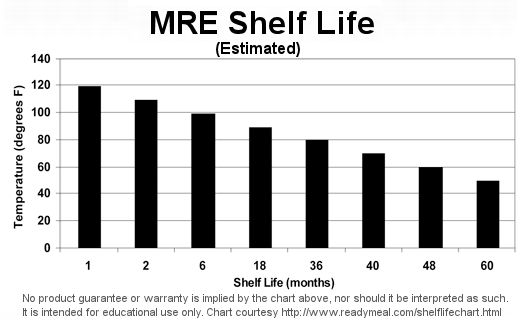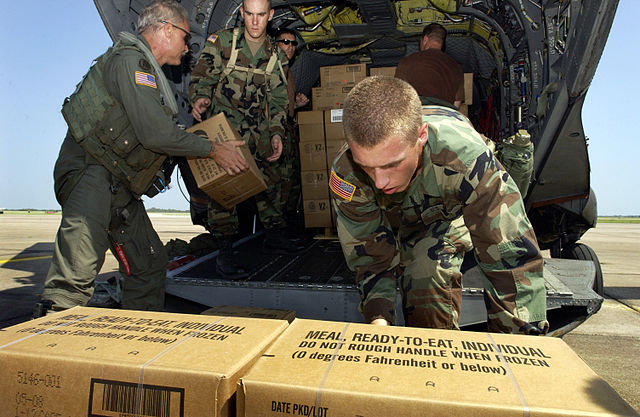Key Points:
- MRE stands for Meals Ready to Eat
- An MRE is designed to be a self-contained, complete meal in a strong package designed to withstand the elements and function in harsh condition – i.e. war and military applications.
- MREs are healthy to eat but are designed for maximum nutrition and caloric intake, not as a long-term healthy food.
- Research indicates that eating too many MREs can cause constipation.
- MREs are designed to last around 3.5 years.
MREs – yum! Soldiers carry them and preppers stock them, but are MREs healthy to eat? The long shelf life, the salty taste, the plastic packaging. Nothing quite says “Git in my belly” like an MRE! What’s in an MRE? How long do they last? Are they worth the money?

Let’s explore those questions and more, but first…
Table of Contents
A Brief History of the MRE
You know the saying, an army marches on its stomach. Hauling battle gear, marching for days on end, it takes a toll on the human body. That much physical activity demands FOOD. In the very early days of warfare, soldiers had to hunt their food. They pillaged for food. Mongols even marched with herds of cows and sheep on their campaigns. In 1775 early America, a soldier’s ration included one pound of beef or salted fish, one pound of flour or bread per day, three pounds of peas or beans per week, one pint of milk per day, one pint of rice per week, on quart of spruce beer or cider per day, and a little molasses (source).
Related article: How to Make Your Own “MRE” at Home
Eventually, the Meal, Ready to Eat (MREs) came along. They were adopted as combat rations by the Department of Defense in 1975, but large-scale production didn’t really begin until the late 70s. Prior to that they were referred to as MCIs, or “Meal, Combat, Individual.” Soldiers didn’t really move to eating MREs until the early 80s. MREs then replaced the largely canned rations that had sustained U.S. soldiers through WWII and the Vietnam War. The MREs were tested thoroughly beginning in 1983, as they were distributed to troops. Changes were made over time.
- 𝐌𝐢𝐥𝐢𝐭𝐚𝐫𝐲-𝐆𝐫𝐚𝐝𝐞 𝐌𝐑𝐄 𝐏𝐚𝐜𝐤: Composed of 12 delicious meal varieties, our MRE meals military case contains 12 Meals-Ready-to-Eat. This army food MRE meal is compatible with and caters to a wide variety of dietary restrictions.
- 𝐄𝐱𝐭𝐞𝐧𝐝𝐞𝐝 𝐒𝐡𝐞𝐥𝐟 𝐋𝐢𝐟𝐞: Count on the longevity of our genuine military MREs, meticulously crafted to withstand the test of time. Crafted to endure, the Inspection Date 2023 or Better army MRE food meal boasts a shelf life of 5+ years when stored below 70 degrees, ensuring they're always ready to fuel your adventures, whether it's tomorrow or years down the line. Inspection Date 2023 or Better.
What’s in an MRE?
The The MRE is designed to be a self-contained, complete meal in strong packaging to withstand elements. The typical MRE contains the following: The typical MRE contains the following:
- Entree (the main course; spaghetti as an example)
- Side Dish (a vegetable of some sort)
- Cracker or Bread
- Spread (peanut butter, jelly, etc.)
- Dessert (cookie, mini cake, etc.)
- Candy
- Beverage Mix (coffee, tea, etc.)
- Seasoning (when appropriate to dish)
- Flameless Ration Heater (elements to heat the dish)
- Utensils

According to The Navy SEAL Nutrition Guide:
Field rations are designed to supply adequate energy and nutrients for a particular type of mission. Since the duration and environmental conditions of missions vary, different types of operational rations have been developed. For example, there are cold weather rations for frigid conditions, and lightweight rations for missions lasting no longer than 30 days. These rations have different caloric contents with varying proportions of fat, protein, and carbohydrate to meet the nutritional demands of the various conditions.
At present (it’s always changing), there are currently 24 different varieties of MREs. There are also religiously-certified meals (think Kosher and Halal) that are available upon request.
Are MREs Healthy to Eat?
“Healthy” is a relative term here. Is eating MREs on par with a diverse meal of fresh organic fruit and vegetables? No. But, given the MRE’s intended application (shelf life and caloric intake), they’re designed for maximum nutrition within their design limitations. Let’s dig a little deeper.
Each MRE contains, on average, 1,250 calories. Thus, a soldier that is stuck eating three MRE meals a day is getting the military’s recommended daily allowance of vitamins, minerals, and calories.
The devil is in the details, however. There are often many processed ingredients including high-fructose corn syrup, caramel coloring, sugar, MSG, hydrogenated vegetable oils, artificial flavoring, etc. But MREs aren’t supposed to be daily meals. They’re supposed to get you through the mission at hand.
Will Eating MREs Make You Constipated?
Yes, the statement that MREs will make your poop hard as a rock is backed up by scientific study. After three weeks of eating only MREs, volunteers in the study had fewer instances of pooping than those who did not eat MREs. The difference, researchers concluded, was due to the lack of good bacteria found in fresh foods that gives those bowels a little extra kick in the butt…
How Long do MREs Last?
According to Go Army, the practical answer is an MRE is designed stay good for three and a half years at 80 degrees F, or nine months at 100 degrees F. The “real” answer is that so long as the MRE package is not damaged in any way, MREs will last “a long time.” They may start to degrade more over time, but they’re still very edible for years after their production date.
See the following chart for more specific temperature-to-shelf life estimates.

So, if you’re thinking about buying a big box of MREs for your food storage room, plan accordingly. It may be wiser to just buy a 12-pack for your bug out bag. Then save that extra money for freeze-dried foods with a longer shelf life.
Are MREs Worth the Money?
This is a question only you can answer. They’re not cheap, but they do have their applications. In my opinion, for the prepper, they’re best suited to the bug out bag or hiking pack. The roughly three-year shelf life is too short for long-term food storage (when compared to quality freeze-dried foods or simple rice and beans). However, they are a good alternative to individual Mountain House packets when you want a bit more variety and – in particular – don’t want to carry a stove to heat water. That is the MRE’s biggest advantage – the heating elements are included!

What’s your MRE experience? Have you had them? Enjoy them? Do you stock them?



7 comments
Really liked this breakdown. They aren’t the healthiest, but as you said, they also aren’t supposed to really be eaten ALL the time. I like to mix up my food storage and add in some MRE’s for ‘once and a while’. For what they are, they actually aren’t too pricey and some military surplus stores have great prices on ’em. Anyway, great breakdown!
Thanks, Morgan.
About three years ago while visiting my older brother, we had a few drinks and at the end of the evening decided to do a “field study” of an old MRE. It was frankfurters from the 80’s. We opened it and gave it the sniff test. Smelled fine but was out of shape, didn’t look like little hot dogs anymore but we ate it along with the other items and it still tasted the same and we didn’t end up in the hospital so we concluded that as long as they are stored well, they’re still edible.
Too funny. You’re a brave soul. Thanks for sharing.
Been living off a pretty steady diet of them since hurricane Ida, not so great long term diet. Note, storage allowing exposure to, what I guess ( I got them third hand) were, organic solvents apparently allow the vapors to eventually transfer through the plastic pouches to contaminate the contents. But the foil (?) pouches’ contents seemed to be fine. So, entree, vegetables, and candy were bad. The cookies, crackers, and bread we’re good. Also, from people storing them in open buildings or outside, varmints have learned to tear open the side of the case to extract and disassemble the MREs access the individual contents. Cans may still be best disaster option.
Bye-bye from the bayou.
Love hearing firsthand, real life experiences. Thanks for chiming in.
Being in the Army back in the 80’s, after eating MRE’s for 30 days at NTC these thing locked me up and I could not poop and when I did, it was sand stones…lol. As for their shelf-life? A buddy of mine worked for the MRE manufactures and he said they will last a long time (15-20 years) if kept at a stable temperature. They will lose their vitamin content but will fill you stomach if nothing else is available.